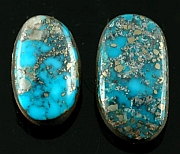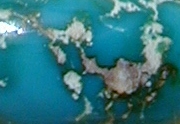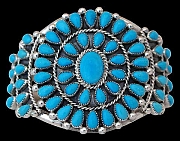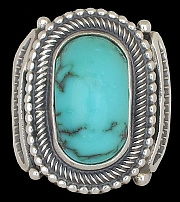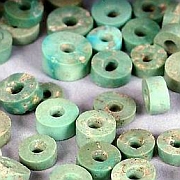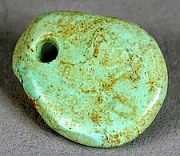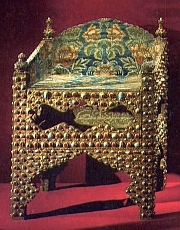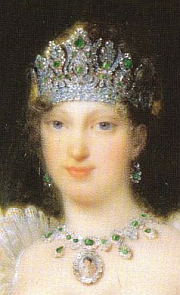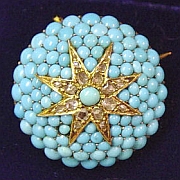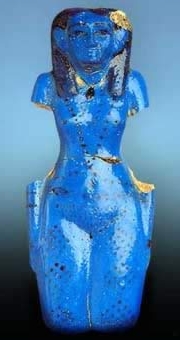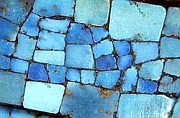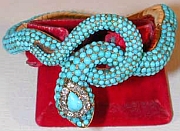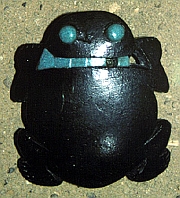No other gem than turquoise on her breast Description An opaque gemstone, the color of turquoise ranges from pale yellow to robin's egg blue to deep greenish-blue to true green. Copper brings out the blue hues, and iron brings out the greenish or yellowish hues. A lot of turquoise is found with a decorative veining, referred to as matrix. Turquoise matrix can be made of a number of different minerals, which vary according where the turquoise was formed. Matrix can be very light and wispy to very heavy and distinctive, and it can range in color from white to silver or black to any shade of brown. Often the matrix is a distinctive marker of where the turquoise was mined. Turquoise is found in many areas around the world, usually in arid regions in igneous rock (volcanic rock) formations that contain a high amount of copper. Caring for Turquoise Turquoise is a relatively soft stone that needs special care. Turquoise will absorb oils and chemicals from the skin and even the air. It may change color over time, and care should be taken to avoid exposure. Do not polish turquoise. Do not use any kind of jewelry cleaner or silver polish on turquoise. To polish silver jewelry with turquoise gemstones, use a soft silver polishing cloth, avoiding the gemstones. North America: Turquoise with Matrix In North America, turquoise is found in Arizona, California, Colorado, Nevada, New Mexico, and Virginia. North American turquoise tends to be more greenish and has a distinctive veining, called matrix. Turquoise matrix ranges in color and pattern from faint white or grey veining to heavy brown or black veining. The matrix helps to identify a type and quality of turquoise. Most turquoise found in North America is of poor quality, being pale or too soft. In fact, only about ten percent of the turquoise found in North America is of gem quality. Excellent gem quality turquoise comes from the Arizona Mines, and while in 1911 the first examples of crystalline turquoise were discovered in Virginia, the state is not known for gem quality turquoise. Iran: Robin’s Egg Blue Turquoise The world’s most precious turquoise, which includes the coveted robin's egg blue color, comes from northeastern Iran and is referred to as Persian turquoise. Turquoise gems from Iran have little to no matrix, few blemishes, and are among the most valuable of the opaque gemstones. History Naming Turquoise Pliny the Elder, a naturalist and philosopher of ancient Greece, who wrote the first encyclopedia of natural history, called turquoise callais. The ancient word callais actually referred to a particular color ranging between a perfect sky blue and the color of verdigris, the beautiful greenish-blue patina that forms on copper and bronze. In ancient times, turquoise was actually mined in Persia, and the Persian word for the stone was ferozah, meaning victorious. The Persian stone was taken along trade routes to the hills of Turkey and there sold to French and Italian traders. Thus, turquoise derives its modern name from the old French phrase pierre turquois, meaning Turkish stone. Egyptian Mining on the Sinai Peninsula The history of turquoise the Middle East coincides with the beginning of civilization itself. In the Sinai Peninsula, the ancient Egyptians began mining turquoise around 5,500 BC. The turquoise found in the mines of the Sinai Peninsula was for thousands of years used to make jewelry, amulets, and cosmetics. Mining turquoise in ancient Egypt was a large scale production. Thousands of slaves and a massive company of soldiers traveled to the turquoise mines on the Sinai Peninsula. Soldiers and slaves lived in the mines for months, returning only when fully loaded with copper and precious turquoise. Mining on the Sinai Peninsula continued for many centuries, until the blue veins finally ran out in the final years leading up to the time of Jesus. Many ancient mines were lost to history until they were rediscovered by archaeologists in the late 19th century. Queen Djer’s Bracelets The oldest known jewelry is a set of four gold, turquoise, lapis lazuli, and amethyst bracelets, which were found on the arm of Queen Djer of Egypt. Queen Djer was the wife of the Horus Djer, the third pharaoh of the first Egyptian Dynasty, who ruled around 3100 BC. Queen Djer and her husband were entombed in what was for a long time thought of as the Tomb of Osiris, Egyptian god of the underworld. The Tomb of Osiris at Abydos was originally—and quite shoddily—excavated by the archeologist Emile Amelineau in 1898. Soon after the renowned archeologist William Flinders Petrie gained the right to excavate, and in 1900-1901, Petrie completely re-excavated the tomb. Petrie found the bracelets still on the mummified arm of Queen Djer. The linen coverings had held the beads in place, protected for more than 5,000 years. These four bracelets are the oldest jewelry in history. The second bracelet is about 7.25 inches long and made of alternating gold and turquoise plaques, called serekhs. The plaques represent the façade of the Egyptian palace with the falcon god Horus on top and the name of the Pharaoh Horus Djer inscribed in hieroglyphics. The other three bracelets were made of gold, turquoise, lapis lazuli, and amethyst beads strung on fine gold wire. The exquisite workmanship of these bracelets demonstrate the fine skill of the jewelers in this early period of Egyptian history. Persian Turquoise Soon after the Egyptian mines on the Sinai Peninsula ran dry, the Persian mines in northeastern Iran, began producing the fairest, most valuable and beautiful turquoise ever seen. The Persian mines, located near what is now known as Nishapur in modern Iran, still produce some of the finest turquoise available on the market. In ancient times, fine Persian turquoise was an important commodity, and the gemstone has been found along trade routes and in graves as far north as Turkestan and the Caucasus. Many turquoise amulets, beautifully carved with Islamic and Persian Proverbs, have been found in graves that date to about 600 AD. Persian turquoise has always been known for its fine clear robin’s egg blue color, and today, the term Persian often refers to the clear sky blue color of turquoise rather than its origin. Anasazi Turquoise The Anasazi were an ancient Pueblo People of an area of the southwestern United States that is currently known as the four corners of Colorado, New Mexico, Arizona, and Utah. In modern times, Navajo, Zuni, and Hopi cultures occupy the same space. By the year 1,000 AD, the Anasazi people had developed an impressive turquoise mining industry. The Anasazi turquoise mines were located in New Mexico, and travel to and from the turquoise mines facilitated an advanced trading network. The most important center of Anasazi trade and culture was at Chaco Canyon, located in what is currently northwestern New Mexico. The Anasazi at Chaco Canyon traded with people from throughout North America and Mexico. The Anasazi economy was built entirely on turquoise. Turquoise beads were used as a medium of exchange and were displayed as symbols of prestige. Evidence at Chaco Canyon shows that the Anasazi were sophisticated jewelers and craftspeople. Fantastic turquoise jewelry and artifacts have been found in gravesites throughout the Anasazi territory, including beads, pieces of turquoise inlay, carvings and objects inlaid with turquoise, and carved turquoise pendants. Anasazi craftspeople were also known for their basketry and distinctive black and white pottery, which they traded for goods, including copper bells, shells, and parrot feathers. Shakespeare’s Turquoise Turquoise did not gain favor with European fashion until the late middle ages, after trade with the East had been established. Shakespeare’s The Merchant of Venice features a turquoise ring as a symbol of love and loyalty. In the play, which was published in 1598, Shylock, while still a bachelor, was given a turquoise ring by his lover and future wife Leah. Shylock later gave the ring to his daughter Jessica, who traded the ring for a monkey, breaking Shylock’s heart. After the time of Shakespeare’s The Merchant of Venice, the giving of a turquoise ring became a symbol of loving devotion. Godunov’s “Persian Throne” In 1604, as a token of the strong diplomatic ties between Russia and Persia, the renowned Persian ruler Shah Abbas I (1571-1629) presented to Russian Tsar Boris Godunov (1551-1605) a truly magnificent gold-plated throne. The Tsar’s “Persian Throne” was made in a traditional oriental style with a low back that flowed into low armrests. It was covered in thin plates of sculpted gold sheets and inlaid with thousands of precious jewels, including more than 800 large Persian turquoises, hundreds of smaller turquoises, more than 500 rubies, and at least 150 whole pearls. Empress Marie Louise’s Diadem The diadem of French Empress Marie Louise (1791-1847) was originally part of a parure, a set that included a diadem, a pair of earrings, and a comb. The parure, originally inlaid with 79 exquisite emeralds, was a wedding present from Marie Louise’s husband, the emperor of France Napoleon Bonaparte (1769-1821). After the fall of Napoleon, Marie Louise took many of her royal jewels, including the emerald parure, and went back to her family, the Hapsburgs, in Vienna. The emerald parure stayed in the Hapsburg family until 1953, when the diadem was sold to the jewel house of Van Cleef and Arpels, where all 79 emeralds were promptly replaced with precious Persian turquoise. Thus, possibly the most beautiful item of turquoise craftsmanship ever seen was created. Van Cleef and Arpels sold the newly inlaid turquoise diadem to cereal heiress-turned-philanthropist Marjorie Merriweather Post (1887-1973), who donated the near-priceless diadem to the Smithsonian Institution in 1966. Victorian Turquoise The whimsical turquoise jewelry of the late Victorian Period, about 1880-1901, was in essence a reaction to the first twenty years of Queen Victoria’s mourning. In 1861 the Queen’s Prince Consort Albert (1819-1861) died of typhoid fever. Queen Victoria (1819-1901) dealt with his death by mourning for 40 years until she died in 1901. The Queen wore somber black clothing and black gemstone jewelry. Popular gemstone jewelry of the time was made with jet, hematite, black onyx, and black tourmaline. Society responded empathetically to the Queen’s mourning, wearing black from head to toe. However, after twenty years of this behavior, society grew bored with black. Beginning around 1880 jewelry began to incorporate bright, light-hearted colored gemstones and whimsical designs. Cheery settings, with fun motifs of hearts and star bursts, incorporated petite sky-blue turquoise gemstones, pink coral, white pearls, and diamonds. During this time, turquoise experienced a brief period of popularity. Folklore Egypt and the Lady of Turquoise In ancient Egypt turquoise was associated with feminine symbols of love and rebirth. Hathor, the Egyptian goddess of marriage and joy, was known as the Lady of Turquoise. The Egyptian word for turquoise means delight. Turquoise also stood as a symbol of the ancient Egyptian goddess Maat, who as a moon goddess illuminated the darkness and represented truth and world order. The ancient Egyptians were the first to create an artificial turquoise called faïence, which was actually a kind of glass-like glaze. Faience was made of silica (sand), lime, and powdered copper, which gave the faience its turquoise color. With a little water, the faience could be molded like clay or painted onto ceramic objects. Upon firing, the silica clay would melt and flow into a glassy glaze, much like modern ceramic glazes. Faience beads were made by pressing solid lumps of copper-enriched silica clay into molds and then firing. Turquoise of the Aztecs In the Americas, turquoise represented male power and was worn by kings and warriors. The Aztecs held turquoise is the very highest esteem. The 16th century Aztec emperor Montezuma II warned the Spanish explorer Hernando Cortés and his soldiers that if they laid a finger on even one piece of precious Aztec turquoise, the gods would seek out the Spaniards, burning their homes and killing their unborn children. The threat was lost on the Spaniards, who cared only about gold and considered turquoise a worthless stone. The Aztecs inlaid turquoise, together with gold, quartz, malachite, jet, jade, coral, and shells, into ceremonial mosaic objects such as knives, shields, and masks, some of which used human skull bones as a base. Turquoise of Native Americans Native Americans including the Anasazi (Pueblo), Navajo, and Apache peoples cherished turquoise as a protective amulet. The Navajo tipped their arrowheads with turquoise, believing that the gemstone gave archers dead aim. The Anasazi prospered greatly from their production and trading of turquoise objects, including mosaics, sculptures, beads, and pendants. The distinctive silver jewelry produced by the Navajo and other Southwestern Native American tribes today is a rather modern development, a result of European influences, thought to date from about 1880. Dreaming of Turquoise In Victorian times, dreaming of turquoise foretold of great prosperity. Symbolism Hour: 5:00 am Day: Saturday
Season: Winter Birthstone, modern, alternative: December
Birthstone, pre-1900, Polish: December Anniversary, traditional: 11th Angels: Cassiel and Asmodel Planet: Venus Zodiac: Taurus US States: Countries: |
|

